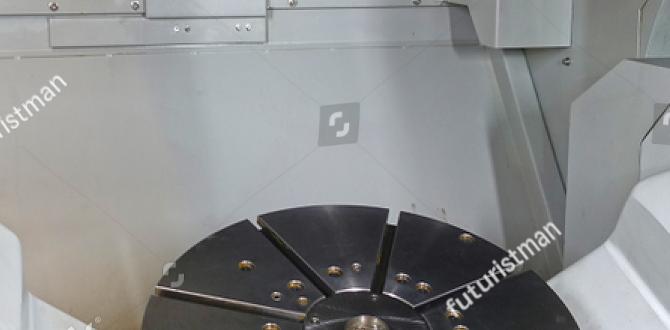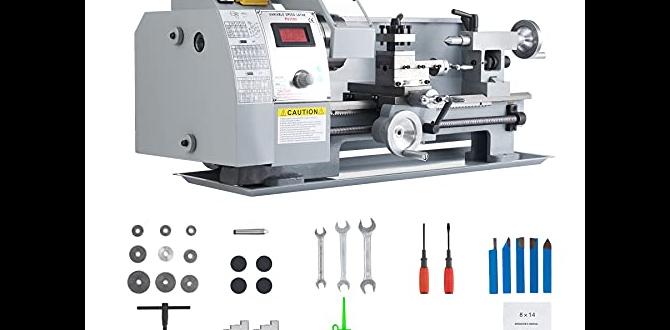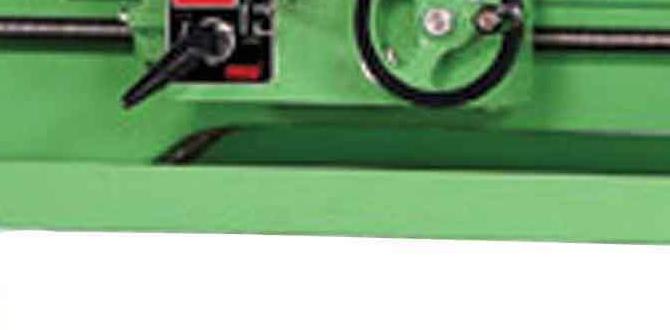For flawless MDF cuts with minimal wobble, a 3/16-inch long-reach carbide end mill with an 8mm shank is your go-to tool. Designed for deeper access and superior stability, it tackles MDF like a dream, reducing flutter and ensuring clean, precise edges every time.
Working with Medium-Density Fiberboard (MDF) can sometimes feel like a battle against fuzz and frustrating chatters. You’ve got a fantastic project in mind, but getting those clean cuts and intricate details can be a challenge, especially when you need to reach into deeper areas or work with delicate designs. It’s incredibly rewarding when you achieve those crisp, clean edges that make your projects shine. This guide is designed to make that process simpler and more effective, especially when tackling those deeper cuts. We’ll walk through exactly how to choose and use a specific tool that will transform your MDF work.
Your Secret Weapon: The 3/16-inch Long Reach Carbide End Mill
When it comes to cutting projects with MDF, the right tool makes all the difference. For those moments when you need to achieve clean cuts in deeper sections of your material or when you want to minimize any sort of wobble or vibration, a specialized end mill is key. We’re going to focus on a particular hero: the 3/16-inch long-reach carbide end mill, often found with an 8mm shank. This tool is incredibly well-suited for MDF because of its unique design, which helps combat common machining issues.
Why is the 3/16-inch Long Reach Carbide End Mill Perfect for MDF?
MDF is a fantastic material – it’s smooth, consistent, and takes paint and finishes beautifully. However, it can also be quite abrasive and prone to chipping or fuzzing along the cut line if you’re not using the right approach. This is where our chosen end mill shines.
Material is Key: Carbide: Carbide is an incredibly hard and durable material. This means it can withstand the abrasion of MDF and hold its cutting edge for much longer than softer steels. For MDF, which can be a bit tough on tooling, carbide is a no-brainer. It ensures more consistent cuts over time.
The 3/16-inch Diameter Sweet Spot: A 3/16-inch diameter is a versatile size. It’s substantial enough for many detailed cuts and for clearing out material efficiently, but it’s also fine enough for intricate work. For smaller CNC routers or machines with limited spindle power, this size is often ideal.
Long Reach for Deeper Projects: The “long reach” aspect is crucial. It means the flute length of the end mill is extended, allowing you to cut deeper into your material without the shank of the tool interfering with your workpiece or CNC machine bed. This is essential for projects that require multi-layer cuts or for creating pockets that go further down. You can achieve depths that standard end mills simply can’t handle.
The 8mm Shank Advantage: While many end mills use fractional inch shanks (like 1/4-inch or 1/8-inch), the 8mm shank is very common, especially in European-designed CNC equipment. It provides a robust connection to your spindle collet, offering greater rigidity and reducing the chance of the tool slipping. This increased rigidity is vital for achieving clean cuts in MDF, as it minimizes deflection – that unwanted bending of the tool under load that leads to rough edges.
Minimizing Deflection: The Underrated Benefit
Deflection is the enemy of clean woodworking and machining. It’s when the cutting forces push the end mill off its intended path. For MDF, which can resist the cut, this leads to:
Fuzzy Edges: The fibers of the MDF aren’t cleanly severed, resulting in a rough, fuzzy surface along the cut.
Inaccurate Dimensions: The actual cut will be wider or smaller than intended, meaning your parts won’t fit together properly.
Increased Tool Wear: When a tool is deflecting, it’s not cutting efficiently, which can lead to it dulling quicker.
The 3/16-inch long-reach carbide end mill, especially with its 8mm shank, helps fight deflection because:
Rigidity: A thicker shank (like 8mm compared to, say, 1/4 inch) is generally stiffer.
Proper Tool Engagement: The longer reach allows you to set your cutting depth correctly, ensuring enough of the tool’s flutes are engaged without the solid shank rubbing against the material or clamping mechanisms.
Material Properties: Carbide itself is much stiffer than steel, meaning it bends less under load.
Choosing the Right 3/16-inch Long Reach Carbide End Mill for MDF
Not all end mills are created equal, even within the same size and type. For MDF, you want to pay attention to a few key features.
Key Features to Look For:
Number of Flutes: For materials like MDF and other composites, two-flute (2-flute) end mills are often preferred.
2-Flute: These generally offer better chip clearance, which is important for MDF as it produces a lot of fine dust. They also tend to cut more aggressively. This is often the best choice for softer woods and MDF.
4-Flute: While good for harder materials and finishing, 4-flute end mills can sometimes struggle to clear chips in softer, dust-producing materials like MDF, leading to overheating and rougher cuts.
Type of Cut:
Single-Flute: These are excellent for plastics and can work on MDF, offering very fast material removal and good chip evacuation. However, they can sometimes be less effective for achieving fine detail or a smooth finish compared to a well-designed 2-flute.
Compression or Combination Bits: For cutting MDF cleanly, especially on the top surface, a compression bit can be a revelation. A compression bits has up-cut flutes on the bottom half and down-cut flutes on the top half. This pulls the material up from the bottom while pushing it down from the top, creating a clean edge on both surfaces. While not always available in long-reach 3/16″, it’s worth keeping an eye out for them. If a pure long-reach is needed, a good 2-flute is generally the way to go for MDF.
Coating: Some carbide end mills have specialized coatings (like TiN, TiAlN, or ZrN). While these are more common in metal machining, a good quality, uncoated carbide end mill will serve you very well for MDF. The primary benefit of coatings is increased hardness and heat resistance, which can extend tool life in demanding applications. For MDF, the inherent hardness of carbide is usually sufficient.
Helix Angle: The helix angle is the spiral angle of the cutting edges. A steeper helix angle (e.g., 30-45 degrees) generally results in a smoother cut and better chip evacuation, which is beneficial for MDF.
Where to Find Them:
You’ll find these specialized end mills at:
Industrial Tool Suppliers: Companies like McMaster-Carr, MSC Industrial Supply, and Grainger are great sources for high-quality industrial tooling.
Online Machining Retailers: Websites dedicated to CNC and machining tools often carry specific end mills for woodworking and composite materials.
Specialty Woodworking Stores: Some higher-end woodworking stores or their online counterparts might stock these.
When searching, use terms like “3/16″ carbide end mill long reach MDF,” “8mm shank 3/16” router bit,” or “composite cutting end mill.
Setting Up Your CNC for MDF with the 3/16-inch Long Reach End Mill
Proper setup is just as important as the tool itself. Here’s how to get your CNC ready for a successful MDF cutting session.
1. Secure Your Workpiece:
This might seem obvious, but a firmly held workpiece is paramount. MDF can move if it’s not clamped down securely, leading to inaccurate cuts and potential tool breakage.
Clamps: Use plenty of clamps around the perimeter of your MDF sheet. Ensure they don’t interfere with the tool path.
Double-Sided Tape: For smaller jobs or intricate parts, high-strength double-sided tape can be very effective when used in conjunction with clamps. Visit a resource like 3M’s industrial tapes page to understand the strength and suitability of different tapes.
Vacuum Hold-Down: If your CNC has a vacuum table, ensure it’s operating at full power.
2. Zeroing Your Axes:
Accurate setup means accurate parts.
X and Y Origin: Set your X and Y zero point (the starting corner for your cut) precisely. This is usually done by touching off on a corner of your MDF sheet or a designated datum point.
Z Zero: This is especially critical for deeper cuts and with a long-reach end mill. You want to set your Z zero point accurately at the surface of your MDF. A Z-probe or a simple touch-off with a metal block can be used. You can learn more about effective CNC zeroing techniques from resources like CNCCookbook’s tutorials. Correctly Z-zeroing ensures your pockets and cut depths are precisely as designed.
3. Dust Management:
MDF produces a significant amount of fine dust. Good dust collection is vital for your health, the longevity of your CNC machine, and the quality of your cut.
Dust Shoe: A dust shoe that attaches to your spindle and follows the tool is the most effective solution. It captures dust at the source.
Vacuum System: Vent your dust shoe to a powerful shop vacuum or dust collector.
Cutting Strategies for MDF with Your 3/16-inch Long Reach Carbide End Mill
How you actually cut the material is where the magic happens. For MDF, we want to cut efficiently while keeping the tool happy and the edges clean.
Understanding the Cut Parameters:
Spindle Speed (RPM): This is how fast the end mill spins. For MDF and a 3/16-inch carbide end mill, a good starting point is often between 18,000 and 24,000 RPM. Higher RPMs can lead to burn marks if feed rate isn’t matched.
Feed Rate: This is how fast the end mill moves through the material. This needs to be balanced with RPM and chip load. A good starting point for MDF is often around 30-60 inches per minute (IPM).
Chip Load: This is the thickness of the material removed by each cutting edge per revolution. For a 3/16″ 2-flute end mill in MDF, a chip load of 0.003″ to 0.005″ is a common range.
Calculation: Feed Rate (IPM) / (Spindle Speed (RPM) Number of Flutes) = Chip Load (inches per revolution)
Example: If you choose 18,000 RPM, a feed rate of 60 IPM, and a 2-flute bit: 60 IPM / (18000 RPM 2) = 0.00167″ per revolution. This might be a bit low, meaning you might need to increase feed rate or decrease RPM. Aiming for the target chip load ensures efficient material removal without overloading the tool.
Depth of Cut (DOC): This is how deep the end mill cuts in a single pass. For a 3/16″ end mill, it’s generally advisable to not exceed half of the diameter for each pass, so around 3/32″ (0.09375″). The “long reach” aspect allows you to achieve your total desired depth over multiple passes without excessive tool pressure.
Stepover: This is the amount the end mill moves sideways between each cutting pass. For roughing or clearing out material, a stepover of 30-50% of the tool diameter is common. For finishing passes, a smaller stepover (10-20%) will yield a smoother surface.
Recommended Cutting Strategy (Step-by-Step):
1. Program Your Toolpath:
Use your CAM software (e.g., Fusion 360, VCarve, Easel Professional) to define your cuts.
Select your 3/16-inch, 2-flute, long-reach carbide end mill from your tool library. If your software has specific parameters for MDF, use them.
Set your desired depth of cut per pass. For example, if you need to cut 1/2 inch deep, you might program 4-5 passes, each cutting about 0.100″ to 0.125″ deep. This is where the long reach is beneficial; you can maintain a reasonable DOC and reach the full depth.
Choose either “Climb Milling” or “Conventional Milling. For MDF, climb milling generally provides a cleaner finish. In climb milling, the cutter rotates in the same direction as your machine moves forward.
Climb Milling: The cutter chips away from the workpiece surface, leading to a cleaner finish and less strain on the tool.
Conventional Milling: The cutter chips away against the workpiece surface, which can cause more tear-out on materials like MDF.
2. Perform a “Dry Run”:
Before cutting the actual material, run your CNC program with the spindle off but the Z-axis enabled. Watch the tool move over your MDF.
This allows you to verify your toolpaths, check for any collisions with clamps or fixtures, and ensure your zero points are correct for all axes.
3. Set Spindle Speed and Feed Rate:
Start with recommended settings, but be prepared to adjust. A good baseline for MDF is:
Spindle Speed: 18,000 RPM
Feed Rate: 40 IPM
Depth of Cut: 0.125 inches (or 1/8 inch)
Stepover: 40% for roughing, 15% for finishing.
Listen to the sound of the cut. A good cut should sound like a consistent “whoosh” or “shh” rather than a squeal (too fast RPM or feed) or a forceful grinding (too slow feed or too deep DOC).
4. First Pass – Light Cut:
For any critical or deep cuts, it’s wise to do a very light first pass at a shallow depth (e.g., 0.05 inches). This helps to ensure everything is aligned and you can verify the cut quality before committing to the full depth.
5. Execute the Full Cut:
Turn on your spindle and dust collection.
Start the cutting program.
Monitor the process closely. Watch for any unusual noises, excessive dust buildup (indicating poor chip evacuation), or signs of tool chatter.
6. Adjust if Necessary:
If you hear chatter or see rough edges: The tool might be deflecting. Try:
Reducing the depth of cut per pass.
Slightly increasing the feed rate (be careful not to exceed recommended chip load).
Ensuring your workpiece is tightly secured.
Checking that your collet is clean and securely holding the end mill.
If the cut looks burned or hazy: The tool might be running too slow for the feed rate, or chip evacuation is poor. Try:
Increasing the spindle speed (RPM).
Ensuring your dust collection is effective to clear chips.
Reducing the feed rate slightly if chip load is too high.
If you need a smoother finish:
Program a final finishing pass with a smaller stepover (e.g., 10-15%) and a slightly slower feed rate.
Example Cutting Parameters Table
This table provides a good starting point. Always consult your CAM software and experiment on scrap material.
| Parameter | Value for 3/16″ Long Reach Carbide End Mill in MDF | Notes |
| :——————– | :————————————————- | :————————————————————————————————- |
| Tool Type | 3/16″ Carbide, 2-Flute, Long Reach, 8mm Shank | Specific for MDF, focusing on chip clearance and strength. |
| Spindle Speed (RPM) | 18,000 – 22,000 | Start lower and increase if needed. Listen for signs of burn or excessive heat. |
| Feed Rate (IPM) | 30 – 60 | Adjust based on spindle speed to maintain desired chip load. |
| Depth of Cut (DOC)| 0.0625″ – 0.125″ (1/16″ – 1/8″) | Depends on the material thickness and rigidity of your CNC. Long reach allows deeper total depth over passes. |
| Stepover (Roughing)| 30% – 50% | For removing bulk material efficiently. |
| Stepover (Finishing)| 10% – 15% | Provides a smoother surface finish by taking smaller, overlapping cuts. |
| Plunge Rate (IPM) | 15 – 30 | Slower than feed rate to avoid shock on entry. |
| Milling Strategy | Climb Milling | Generally yields a cleaner edge on MDF. |
*Note: These are starting points. Always test on scrap material and adjust based on






